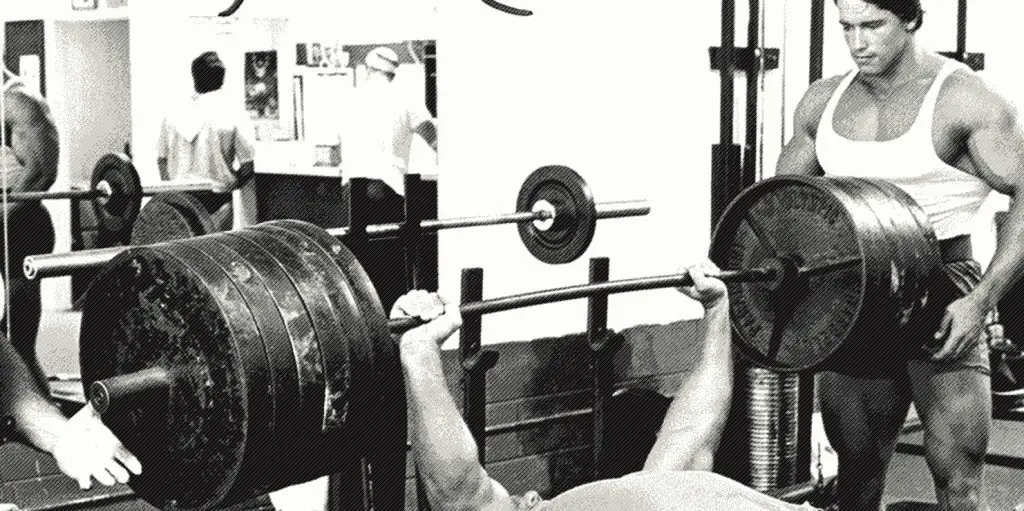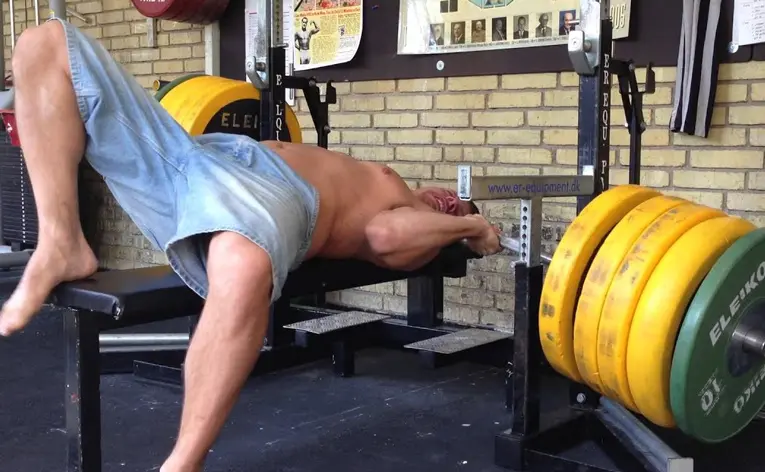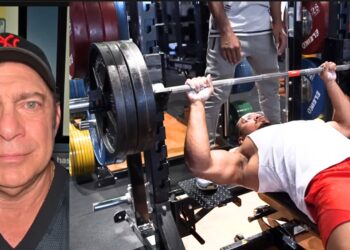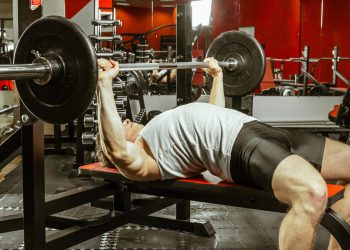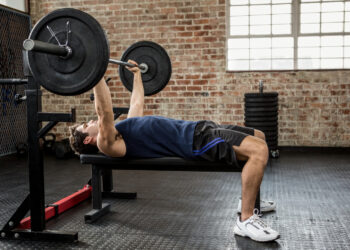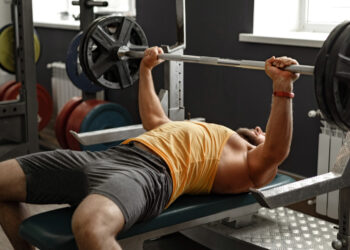In gyms all around the world, Monday is chest day! Who doesn’t enjoy starting their week with a good pec workout? There are lots of exercises you can use to train your chest, but two of the most common choices are the bench press and the chest press.
These exercises certainly look very similar and even work most of the same muscle groups, but they’re also different enough that they need to be considered separately. Depending on your goals, one may be better than the other.
In this article, we’re going to explore the differences and similarities of these two classic upper-body exercises and reveal some variations of each one so that you can choose the right one for your goals.
Bench Press 101
The bench press is probably the most commonly performed strength training exercise on the planet. When exercisers meet, invariably, at some point the conversion will turn to who can bench the most. A big bench press is a badge of honor amongst lifters.
While bodybuilders like the bench press, so too do athletes from most sports, and it’s also one of the disciplines contested in the sport of powerlifting. It can be used to achieve several different training goals, including building muscle, increasing strength, and improving upper body muscular endurance.
The NFL uses the bench press to assess upper body pressing strength, with athletes required to do as many reps as possible with 225 pounds. The current record is an astounding 49 reps!
Level Up Your Fitness: Join our 💪 strong community in Fitness Volt Newsletter. Get daily inspiration, expert-backed workouts, nutrition tips, the latest in strength sports, and the support you need to reach your goals. Subscribe for free!
The bench press is a compound exercise. This means it involves multiple joints and muscle groups working together. The main muscles involved in the bench press are:
- Pectoralis major – known as the pecs for short, this is the muscle group that makes up your chest. The pec’s primary function is horizontal flexion of the shoulder joint.
- Anterior deltoids – this is your front shoulder muscle. It works alongside the pecs to flex your shoulder joint.
- Triceps brachii – usually just called the triceps, this is the muscle on the back of your arm. Its role in the bench press is elbow extension.
- Latissimus dorsi – despite being a back muscle, the lats play an important part in bench pressing.
- They help stabilize your shoulders, providing a stable base from which to raise and lower the weight.
- Rotator cuff – the collective term for the subscapularis, teres minor, and supraspinatus muscles, which help stabilize the shoulder joint.
- Serratus anterior – this is the saw blade-shaped muscle over and between your upper ribs. It helps keep your scapulae flat against your upper back during bench presses, increasing upper body stability.
- Middle trapezius and rhomboids – located between your shoulder blades, your mid traps and rhomboids pull your scapulae together to stabilize your shoulder joint.
- Biceps brachii (short head) – the short head of the biceps is located on the front of your upper arm. Its function is to stabilize your shoulder and flex your shoulder joint.
- Core and lower body – for an upper-body exercise, the bench press also involves a lot of lower-body activity. The harder you brace your core and legs, the more stable you’ll be. Increased stability means less wobbling and wasted energy, and a better bench press performance. The bench press IS an upper body exercise, but your legs and core are involved too, albeit to a lesser degree.
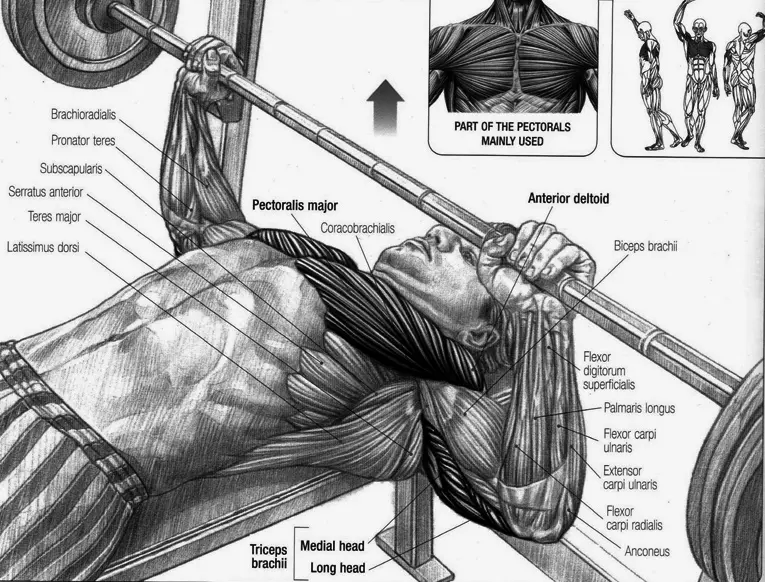
Bench Press Benefits
One of the reasons the bench press is such a popular exercise is that it’s so darn effective! If it didn’t work, it would have fallen out of favor decades ago. Bench pressing can be very beneficial, but those benefits depend on the amount of weight you use and how often you do this exercise. However, the main benefits are:
- Increased pec size – the bench press is a proven mass builder
- Improved upper body strength
- Better muscle power – especially when done explosively
- Bigger, stronger triceps
- Increased upper body bone density
How to Bench Press
A lot of lifters think they can bench press but fail to do this important exercise properly. Incorrect technique increases your risk of injury and will also limit the amount of weight you can lift or the number of reps you can perform. There are several different bench press variations, discussed in the next section, but the basics are:
- Lie on your back on the bench with your eyes directly beneath the bar. Reach up and hold the bar with an overhand, slightly wider than shoulder-width grip. For most bench press variations, your forearms should be vertical at the bottom of each rep.
- Brace your abs, pull your shoulders back and down, arch your lower back slightly, lift your chest up toward the bar, and push your feet into the floor. This will help stabilize your body.
- Unrack the bar and hold it directly over your chest.
- Bend your arms and lower the bar with control until it lightly touches your sternum. As the bar descends, tuck your elbows down and slightly inward toward your sides. Do not bounce the bar off your chest. Instead, imagine you have a pane of glass on your chest and touch the bar down very lightly.
- Push your bar up, flaring your elbows as the bar nears the top of your rep. Extend your arms fully without locking your elbows.
Bench press variations and alternatives
There are lots of bench press variations, as well as exercises that are very similar. Here are the main ones you can use to add variety to your workouts.
| Bodyweight options | Options with weights | Machines/equipment |
| Push-ups | Incline barbell bench press | Board press |
| Plyo push-ups | Decline barbell bench press | Bench press with chains |
| Dive bomber push-ups | Dumbbell bench press | Bench press with bands |
| Hindu push-ups | Incline dumbbell bench press | Cambered bar bench press |
| Decline push-ups | Decline dumbbell bench press | Football bar bench press |
| Dips | Paused bench press | Smith machine bench press |
| Floor press | TRX push-ups | |
| Paused bench press | Chest press machine* | |
| Close grip bench press |
*Discussed in-depth in the next section.
With so many bench press variations to choose from, there is no reason to exclusively use barbell bench presses to build or strengthen your chest. Add variety to your upper body workouts with any of these effective alternatives.
Chest Press 101
Free weight and bodyweight exercises predate strength training machines by hundreds if not thousands of years. But, nowadays, you’ll be hard-pressed to find a gym that doesn’t offer a wide range of machines to train your muscles.
A lot of fitness experts like to argue that strength training machines are inferior to free weights, but that isn’t really true. They’re just a tool, and like any tool, there is a right time and a wrong time to use them.
The chest press machine works many of the same muscles as the bench press:
- Pectoralis major
- Anterior deltoids
- Triceps
- Biceps (short head)
- Rotator cuff
- Middle trapezius and rhomboids
- Latissimus dorsi
However, because the machine balances the weight for you, training with a chest press machine tends not to involve as many stabilizers and other accessory muscles. Core and lower body muscle activation are also much lower.
Chest Press Benefits
Chest presses offer many of the same benefits as the bench press. But there are a few additional benefits that may make it a better choice for some exercisers:
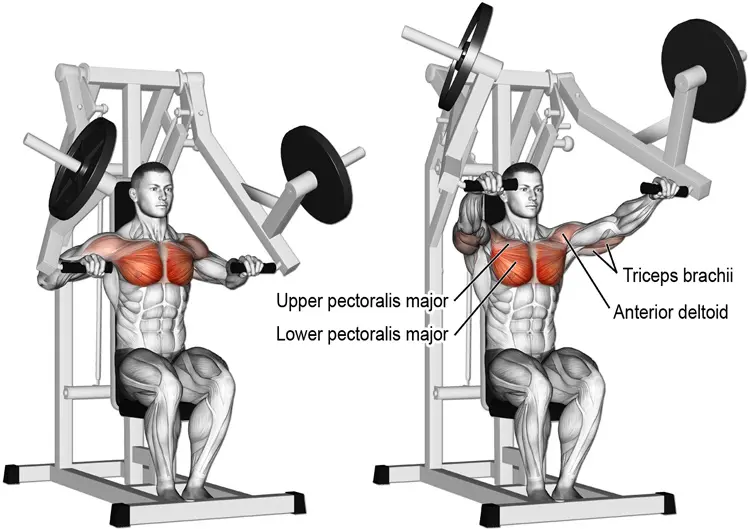
- Increased safety – less danger if you should drop the weights
- The lowest weight setting is usually less than a standard 20kg Olympic barbell
- Better for drop sets and other training systems
- Easier to learn
- Potentially better for building muscle mass
How to Chest Press
Because there are lots of different chest press machine designs, and each one works slightly differently, you should ask a personal trainer or fitness instructor how to use the model at your gym. That said, here are some basic guidelines that should fit most machines.
- Adjust the seat height so that the handles are level with the middle of your chest. Adjust the weight.
- Sit down and plant your feet firmly on the floor, pressing your upper back into the bench. Your lower back should be slightly arched. Brace your abs.
- Grab the handles with an overhand grip. If there are several handles available, choose the one that’s most comfortable for your shoulders.
- Extend your arms and press the handles away from you until your elbows are straight but not locked.
- Bend your arms and return to the starting position without allowing the weights to touch down.
Chest Press Variations and Alternatives
The bench press and its variations can all be used as alternatives to the chest press machine. There are also several different types of chest press machines available.
Chest press machine design variations include:
- Plate loaded machines
- Cable machines
- Hydraulic machines
- Seated machines
- Supine (lying) machines
- Incline machines
- Decline machines
- Flat machines
- Smith machine
Chest Press vs. Bench Press
Beginners
Despite looking pretty straightforward, there is a lot to think about when doing bench presses. Because of this, most beginners would do well to have a few sessions using the chest press before moving onto this free weight exercise.
Level Up Your Fitness: Join our 💪 strong community in Fitness Volt Newsletter. Get daily inspiration, expert-backed workouts, nutrition tips, the latest in strength sports, and the support you need to reach your goals. Subscribe for free!
In addition, an Olympic barbell weighs 20kg/45 lbs. which may be too heavy for some novices. That said, the bench press is nothing to be afraid of, and most beginners should be able to do this exercise with some basic guidance.
Building Strength
You can build strength with both these exercises but, if you want to get REALLY strong, barbell bench presses are best. For a start, most chest press machines don’t go heavy enough to build serious pushing power. The bench press is the second lift contested in powerlifting competitions and not the chest press.
There has got to be a good reason for this. Also, because the bench press involves more muscle groups, it could be argued that it’s a more beneficial exercise.

Building Muscle Mass
In theory, the chest press is a better muscle builder. Why? Because with no barbell to balance, you are free to focus on pushing your muscles to failure. However, a lot of bodybuilders have built big chests with the bench press, so it seems that both exercises can work. Instead of trying to choose between these exercises, why not do both?!
Safety
If you fail to complete a rep on bench presses, you could end up pinned under a heavy weight. This could cause injury or even be life-threatening. Lifters often mitigate this risk by using a spotter. A spotter’s job is to offer assistance if the lifter is unable to complete a rep.
That said, because the bar isn’t locked into a fixed path, the bench press may be easier on your shoulders than many chest press machines.
In contrast, if you are unable to complete a rep on a chest press machine, you can just drop the weight, usually without hurting yourself. But chest presses are made to fit average-sized exercisers, and if you don’t fit into those norms, you could find that training on a machine could cause new or exacerbates existing shoulder problems.
Sports Training
Of the two exercises, bench presses are arguably more functional. That means it transfers better to outside the gym. Bench pressing involves lifting a relatively unstable object, and you have to use your whole body to keep the weight on the correct path. In contrast, the chest press guides the weight for you.
Sports generally involve multi-directional movements, and, as such, the bench press is probably the better choice for most athletes.
Chest Workout Using Bench Presses and Chest Presses
Because bench presses and chest presses are both beneficial exercises, there is no need to choose one over the other. For most exercisers, they should be combined so you can enjoy the advantages and effects of both these popular exercises.
Not sure how to combine chest presses and bench presses? We’re here to help!
Here is a chest workout that combines these exercises with a few other chest builders to work your pecs from all angles, plus a bonus move to keep your shoulders healthy.
Use a weight that makes the last 2-3 reps of each set challenging but not impossible to complete in good form. If you are a beginner, do just two sets of each exercise. But, to make the workout harder, do all four sets.
Before you start, remember to warm up and prepare your body for what you are about to do. Start with a few minutes of easy cardio, followed by some stretching and mobility exercises. Finish off your warmup with a couple of sets of bodyweight push-ups and empty bar bench presses.
| Exercise | Sets | Reps | Recovery | |
| 1 | Bench press | 2-4 | 4-6 | 2-3 minutes |
| 2 | Incline dumbbell bench press |
2-4 | 8-10 | 60-90 seconds |
| 3 | Decline cable fly | 2-4 | 10-12 | 60-90 seconds |
| 4 | Chest press | 2-4 | 12-15 | 45-60 seconds |
| 5 | Face pulls | 2-4 | 10-12 | 60-90 seconds |
Wrapping up
In the battle of the pec exercises, there is no clear winner between chest presses and bench presses. Both exercises have their benefits, as well as their drawbacks. The right one for you depends on your training goals and your current level of strength and experience.
The bench press is arguably the most functional exercise because you are responsible for balancing the load, which increases muscle activation and also involves more muscles.
But, if you just want to train your muscles to failure in safety, the chest press might be the better of the two exercises.
Of course, there is no need to choose one exercise and forgo the other – you can do both. For most exercisers, that’s the best option anyway.
Whichever one you choose, or even if you do them both, use good training form and also progress the difficulty of your workouts from one week to the next. If you don’t you could soon find yourself in a progress rut, going nowhere fast.
The bench press AND the chest press are good exercises, so use them both. That said, depending on your goal, you may need to put more effort into one than the other.

